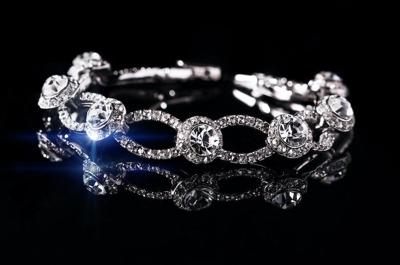
We know that diamonds are stunning, sparkling in daylight and throwing out reflected rainbow shards of light, but why? What is it in a diamond's structure that makes it so very transformative to light?
Reflection
Just as the moon itself does not produce moonlight, diamonds do not shine. What they do – and they do it very successfully – is reflect light, just like the moon reflects the sun's light. After cutting (see below), diamonds are polished to give their external facets a beautifully clean, smooth finish that lends itself well to reflection. The light shining onto a diamond mostly bounces off, showing that beautiful glitter, but some passes through the stone.
Refraction
Diamonds also refract light, which means the light going into the transparent stone is bent or bounced. This emphasizes the amount of light inside the stone, giving the impression that it is actively shining. If the reflection is when light is bounced back from a source, refraction – inside a diamond – refers to how the facets act as mirrors, reflecting the light onwards. With the right cut (see below), the reflections will all emerge from the top or table of the diamond, giving it a beautiful internal sparkle.
Dispersal
This is such a commonplace and practical word for such a beautiful phenomenon! More correctly called chromatic dispersion, this is perhaps best explained by taking a water stream: from a faucet or hose, for example. Now place something over the faucet that breaks up the consistent stream of water, causing it to spray in all sorts of directions—the light inside of diamonds bouncing from facet to facet before emerging into sight again. Bringing along with it, the burst of rainbow fire makes a diamond so beautiful to us all! Another way of describing chromatic dispersion is 'fire,' and the light scattering from a diamond does, indeed, seem to have a fiery element to them!
The Importance of the Cut
An uncut diamond is a somewhat dull object with hardly a sparkle in sight. It is the careful cutting of each stone that allows it to be a superb vehicle for light – and without it, or with low cutting, it is unlikely that a diamond would draw any admiring glances at all, no matter the size, color, and clarity! For more on these, see this diamond color chart. The cut must be designed to remove or minimize any flaws or inclusions while retaining as much good quality diamond as possible – but it is not uncommon for a diamond to shrink by well over half during its cut. Once the flaws have been mapped, the cutter must carefully shape the diamond. Too deep of a cut lose too much light out of the bottom of the diamond. While too shallow, a cut sends light out of the sides. A perfect cut channels the light reflections, refractions, and dispersals out of the top or table of the stone, enhancing the sparkles of light that will draw the eye of any who see it.
And now you know how and why a diamond shines. Hopefully, this will help you to appreciate the love and craftsmanship that go into every diamond that you, whether on young couples' fingers or worn around necks or dangling from ears.



(0) comments
We welcome your comments
Log In
Post a comment as Guest
Keep it Clean. Please avoid obscene, vulgar, lewd, racist or sexually-oriented language.
PLEASE TURN OFF YOUR CAPS LOCK.
Don't Threaten. Threats of harming another person will not be tolerated.
Be Truthful. Don't knowingly lie about anyone or anything.
Be Nice. No racism, sexism or any sort of -ism that is degrading to another person.
Be Proactive. Use the 'Report' link on each comment to let us know of abusive posts.
Share with Us. We'd love to hear eyewitness accounts, the history behind an article.